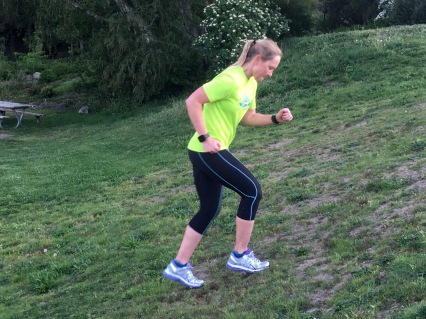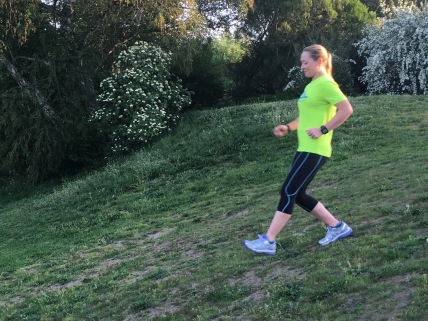
Hill Running Tips
Lucky Seattlites! Wherever you run, there is likely to be a hill. However, we know quite a few athletes who tend to limit their running routes to avoid hills. Proper hill running (both up and down) has some great benefits including building strength and teaching pacing. And we hate to break it to you but the secret to hill running is no secret. To be a better hill runner, you need to run hills. Then when you come to a hill in a race and everyone around you groans in horror, you will be ready!
When running up a hill, you are working harder to overcome gravity. Your body is forced to recruit more muscles in your legs to carry you up the slope. That slope also alters your foot strike and biomechanics. It forces you to transition to a mid-foot strike, stretches your calves as your heel goes below your mid-foot and increases the forces in your calves and ankles. That additional force in your calves and ankles can add extra power and elasticity that can lead to an increased ability to use the force to power you uphill. If you have issues in these areas, you should be careful and very mindful of the increased load.
Form Tips for Uphill Running
Many runners tend to lean into the hill when they start running up a hill. Some forward lean is necessary but many people lean far too much and hunch over. Leaning too far forward limits the ability to bring your knee up, limits the ability to push off with your foot and keeps those glute muscles we’ve worked so hard to develop from properly working. You should think of standing tall as you glide up the hill and remind yourself to keep your gaze up.
Stay relaxed and use your arms. As you swing your arms, your legs will follow. Your cadence should be slightly quicker. Mentally, instead of cursing and grumbling about that dang hill, stay focused on quickly and efficiently getting past the top of the hill.
Once you are hitting the crest of the hill, continue the momentum as you coast and start to recover. Many athletes lose focus once to the top of the hill. Instead continue to drive past the crest and let gravity assist you as you start to go back down the hill.
Form tips for Downhill Running
What goes up must go down. Downhill running can be stressful to your body. It’s important to minimize the impact. The tendency is to lean back which acts to slow your speed. Leaning back also forces a heel strike which can put excessive stress on your legs, hips and back.
Lean forward slightly and keep your cadence quick. Running downhill, your stride will cover more ground but still focus on quick, light feet making sure your hips stay over your feet.
Pacing
Running hills well during training and during races can be challenging. Hill running is a great way to develop a better sense of pacing. The biggest mistake we see in running hills is people charging up the hill. Instead of charging up a hill trying to hit a particular time, work to understand what a pace feels like when running on a flat course. Maintain that same effort as you go uphill. You will slow. You’ll make up some of that time (but not all) as you go downhill.
If a hill is particularly steep or for longer ultra distances, it may even be better to walk on the uphill. Reframe walking and realize that you are power hiking! If you find that you are starting to work too hard for pace, you risk blowing up and jeopardizing the rest of your race. Everyone is different with regard to what feels right with effort. If you walk, remember to maintain the same focus and drive and mentally stay focused on moving forward.
Some final notes
Instead of using the same muscles at the same pace, hill running forces you to use different muscles. Use this to stretch and give yourself a form check. As you get tired even when the course is flat, the clues to stand tall, use your arms, relax, pick your cadence up are all valuable form reminders. We also like to pretend that we’ve hooked onto a tow cable going up a ski mountain and visualize the boost.
Uphill Cues  Do this! Coach Lesley has her gaze up, she is standing tall.
Do this! Coach Lesley has her gaze up, she is standing tall.
 Do This! Here you can see Coach Lesley’s arms moving to assist propelling up the hill. She also has good right leg extension which engages the glutes.
Do This! Here you can see Coach Lesley’s arms moving to assist propelling up the hill. She also has good right leg extension which engages the glutes.
 Don’t do this! Here Coach Lesley demonstrates a common flaw when running uphill. She is leaning far forward from the hips and has her gaze down.
Don’t do this! Here Coach Lesley demonstrates a common flaw when running uphill. She is leaning far forward from the hips and has her gaze down.
Downhill Cues
 Do This! Coach Lesley has a slight forward lean that brings her hips over her knees and feet.
Do This! Coach Lesley has a slight forward lean that brings her hips over her knees and feet. Don’t do this! Coach Lesley demonstrates a common error with hill running. To slow her speed, she leans back. This puts much more stress on the knees, hips and back. And if the ground is very slippery, your leading foot can slip out from under you!
Don’t do this! Coach Lesley demonstrates a common error with hill running. To slow her speed, she leans back. This puts much more stress on the knees, hips and back. And if the ground is very slippery, your leading foot can slip out from under you!
